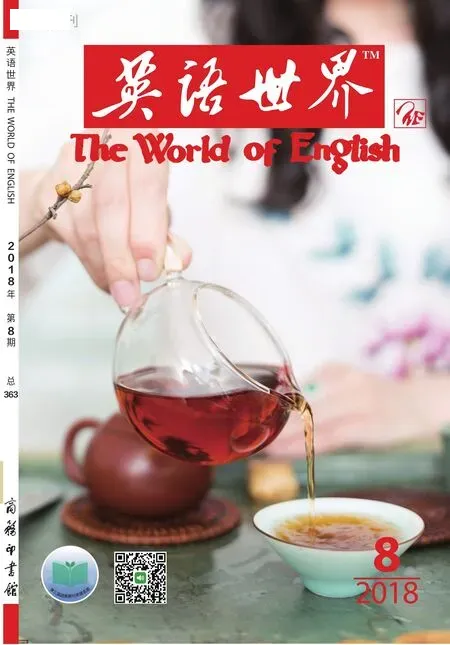The Epic Origins of the Word ‘Tea’
译/邓志辉
As you relax over a cup of tea, it’s easy to forget that wars have been fought over the stuff. That it sparks fierce debate in families and among colleagues. Should it be taken plain or with milk? Can it be sweetened with honey or indulged with butter? Should it be drunk in the afternoon, as the Europeans do, or is it better taken in the morning, as those in China prefer? Yet it is this divisive beverage that, over the centuries, has bound cultures together.
当你沏一杯茶悠闲品尝的时候,很难会想到,眼前这“杯中之物”在历史上曾多次引发战争,到今天也还令家人或同事面红耳赤争论不休:沏茶时应该只用开水冲泡还是该加牛奶?可以兑蜂蜜增甜或恣意加入黄油吗?是该像欧洲人那样午后喝茶,还是最好像中国人习惯的那样在上午喝?不过,尽管分歧如此巨大,千百年来,却正是这一饮品将不同文化紧密联系起来。
How China discovered tea
[2] According to archaeological evidence, tea was first cultivated in China around 1600 B.C., but is said to have been discovered long before that.Legend has it that in 2437 B.C., a deity1deity神。named Shennong was sitting with a cauldron of boiling water next to a bush that suddenly burst aflame. The fi re dried up the leaves of the bush and the heat carried them through the air,dropping them into Shennong’s caul-
“茶”之为饮,发乎中华
[2]考古学上的证据显示,茶叶种植始于公元前1600年左右时的中国,但据称茶叶的发现则远早于此。相传在公元前2437年,神农氏坐在一锅开水旁,大锅边上的一丛灌木突然烧着了,烧焦的叶子随热浪飘到空中,落到神农的锅里。dron. Shennong tasted the leafy water and he could see that tea had the power to counteract the poisonous effects of some 70 herbs.
[3] In the early years of tea cultivation in China, the leaves were unprocessed and had a bitter taste, earning the resulting drink the name ‘荼 tu’, meaning ‘bitter vegetable’. Mandarin’s current word for tea, ‘茶 cha’, didn’t come into recorded existence until 760 C.E., when a scholar named Lu Yu wrote theChajing,or theClassic of Tea, in which he mistakenly omitted a cross stroke from the character ‘tu’, resulting in a much different word: cha.神农尝过泡了叶子的水,发现茶叶能解近70种草药之毒。
[3]在中国茶叶种植的早期,叶子未经加工,味带苦涩,因此得名“荼”(音tu),意指“苦菜”。普通话里现在所用的“茶”字(音cha)直到公元760年才在典籍中出现,当时学者陆羽著《茶经》,一时失误错将“荼”字上方的横线遗漏,结果出现这个完全不同的“茶”字。
How the word ‘cha’ travelled across the world
[4] For nearly a thousand years, tea stayed the secret of the East. Then, in the 1500s, the Portuguese arrived in China. They’d travelled to the Far East hoping to gain a monopoly on the spice trade. But soon after tasting the brew for the fi rst time, the explorers quickly realised its potential and decided to focus on exporting tea instead. The Portuguese called the drink cha, just like the people of southern China did. From the port of Canton2Canton(英语旧称)广州。—around modern-day Guangzhou—Hong Kong, and Macau,the Portuguese shipped the now-processed leaves down through Indonesia,
cha随茶饮,走向世界
[4]近千年里,茶叶一直是东方世界里一种神秘的存在。然后到16世纪,葡萄牙人抵达中国。他们来远东的目的是想垄断香料贸易,但在中国境内第一次品尝到茶之后,这些探险者们意识到其市场潜力,很快决定改为专事茶叶出口贸易。他们学中国南方人称茶叶为cha,并从澳门港和当时广州(大体相当于今天的广州)的港口香港出发,将加工under the southern tip of Africa, and back up to western Europe.
[5] But long before the root word‘cha’ made its way across the oceans to Portugal, another trade route had been spreading tea westward. These tea leaves were traversing China’s Yunnan province along the ‘Tea-Horse’road. With bricks of tea stacked up high on the carriers’ backs, the leaf travelled to India via Persia, where the Chinese‘cha’ turned into the Persianchay’.Depending on the region of India, in most parts tea is known by the Hindi word,chai’. It is also calledcha’ in Bengali, andchaya’ in Malayalam3马拉雅拉姆语,又译马拉雅兰语。印度克拉拉邦马拉雅里人(本义为“山地人”)的语言,是9—10世纪时从泰米尔语分化出来的一种语. But while most Indian dialects use some variation of the root word ‘cha’ to describe tea, there is one exception…过的茶叶途经印度尼西亚,绕过非洲大陆南端,一路海运回西欧。
[5]不过,早在cha这个词根远涉重洋到达葡萄牙之前,另一条贸易线路业已将茶叶输往西方,这就是横贯云南省的茶马古道。沿着这条古道,高高堆在马背上的茶砖经由波斯境内运往印度。在此过程中,cha字在波斯语里变成了chay,在印度则随不同区域出现不同变体,大部分地区都按印地语叫作孟加拉语叫作马拉雅拉姆语则为虽然多数印度方言都采用词根cha的某种变体来命名茶叶,但也有一个例外……
Why the English call it ‘tea’
[6] Around a 100 years after the Portuguese first discovered tea, the Dutch started shipping the leaf from China using their own trade routes. The Dutch fi rst encountered tea in 1607 around the modernday Fujian province, where Hokkien44 Hokkien是东南亚华人对闽南话的称呼,也就是“福建话”。它主要指代闽南话的漳泉口音,即福建、台湾的闽南话。was the major language. Though the written character for tea was ‘茶’, its pronunciation varied depending on the dialect. In
tea之命名,自有英缘
[6]大约在葡萄牙人发现茶叶之后一个世纪,荷兰商船开始沿自己的贸易航线从中国海运茶叶。1607年,荷兰人在现代福建省所在地区初次见识到中国的茶叶,福建当地方言主要是闽南话,而同一个汉字“茶”在不同方言里的发音Mandarin and Cantonese, for example,it’s pronounced ‘cha’, whereas in Wu Chinese5吴语,中国七大方言之一,又称江东话、江南话、吴越语。分布于今浙江、江苏南部、上海、安徽南部、江西东北部、福建西北,使用人口9000多万。it’s ‘dzo’. Following in the linguistic footsteps of the Hoklo folk of Fujian, the Dutch called the drink ‘thee’.
[7] Along with the tea itself, the root word ‘te’ travelled across the oceans,as the Dutch fought through storms for months at a time to carry China’s medicinal miracle to the West. In Tamil,the word for tea leaves isyheyilai’, while the word for the beverage istheneer’, both of which are derived from the root ‘te’. Tamil,of course, is spoken primarily in the southeastern Indian state of Tamil Nadu,which was one of the stopping points on the old Dutch trade route. The root ‘te’also reached Indonesia—a former Dutch colony—where in Javanese the word is pronounced ‘teh’. The Dutch East India Company’s expansive tea importation into Europe gave us the Frenchthé, the GermanTee, and the Englishtea. In fact, soon after the Dutch introduced the British to the wonders of tea, they were hooked.各不相同,例如,普通话和粤语都发音为cha,吴语则作dzo。荷兰人按福建方言将茶音译为thee。
[7]荷兰商船每次要与风雨搏斗数月之久,才能将中国这一神奇的药草运回西方。在此期间,词根te也随之一同漂扬过海。在泰米尔语中,茶叶的对应词是yheyilai,冲泡出的茶水叫■ theneer,两者都是由词根te派生而来——要知道,泰米尔语的主要使用地区泰米尔纳德邦地处印度东南端,当年正是荷兰贸易航线上的一个经停点。此外,词根te还传到了印度尼西亚(原荷兰殖民地),所以爪哇语中茶叶一词的发音是teh。荷兰东印度公司将茶叶广泛引入欧洲各国,因而才有了法语的thé、德语的tee,以及英语的tea。荷兰商人将茶叶传入英国,茶的神奇功效很快让英国人着了迷。
A popular misconception
[8] The popular conception is th at the two major root words ‘te’ and ‘cha’ can be distinguished by whether the beverage was introduced to a certain country
cha、tea之说,流误待澄
[8]人们普遍认为,根据茶叶是由陆路还是水路传入某国,可以区分te和cha这两种主要词根,即大多数通过水by land or by sea. While most countries where tea was introduced by sea use variations of ‘tea’, those to where it travelled by land use variations of the root word ‘cha’.
[9] However, it is believed that the similarity of Japanese, Korean, and Vietnamese pronunciations of tea with the Chinese had nothing to do with the Europeans, but is instead because of the overarching6overarching首要的;概莫能外的。linguistic similarities in these languages. The Japanese, who were fi rst introduced to tea between the years 794–1195 by travelling Japanese monks, call tea ‘cha’, using the same character as China. In Korean tea is also pronounced ‘cha’, and in Vietnamese it is called ‘trà’.
[10] So whether you call it ‘tea’ or‘cha’ or something in between, it is clear that, through everything, tea has brought countries and cultures closer together. Whether you drink it from a bag or loose-leafed, with milk or without, in the morning or afternoon, the way you say ‘tea’ is an experience you share with billions of others. ■路输入茶叶的国家都使用单词tea的变体,而经由陆路传入的国家则多采用cha的变体。
[9]但需注意,日语、韩语和越南语中“茶”字的发音与中文相似,背后原因却与欧洲茶商没有任何关系,而仅仅因为这些语言之间存在极大的相似性。来华游历的日本僧人在794—1195年间将茶叶带回本国,日语中“茶”字的发音(cha)和写法跟汉字相同;韩语中“茶”的发音也是cha,越南语中的发音则是trà。
[10]如此看来,无论你称茶为tea还是cha,或用介乎两者之间的某种称呼,事实都很清楚:这种饮品借由其所蕴含的一切因素,使国与国、文化与文化之间的联系变得更为紧密;无论你泡的是茶包还是散叶,加牛奶还是不加牛奶,在午前喝还是午后喝,你称呼茶的方式与世间其他亿万人的方式都有共通之处。 □

